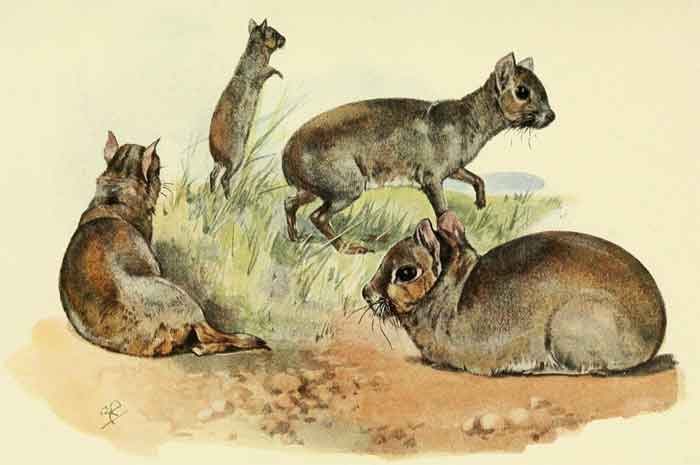
Superregnum: Eukaryota
Cladus: Unikonta
Cladus: Opisthokonta
Cladus: Holozoa
Regnum: Animalia
Subregnum: Eumetazoa
Cladus: Bilateria
Cladus: Nephrozoa
Superphylum: Deuterostomia
Phylum: Chordata
Subphylum: Vertebrata
Infraphylum: Gnathostomata
Megaclassis: Osteichthyes
Cladus: Sarcopterygii
Cladus: Rhipidistia
Cladus: Tetrapodomorpha
Cladus: Eotetrapodiformes
Cladus: Elpistostegalia
Superclassis: Tetrapoda
Cladus: Reptiliomorpha
Cladus: Amniota
Cladus: Synapsida
Cladus: Eupelycosauria
Cladus: Sphenacodontia
Cladus: Sphenacodontoidea
Cladus: Therapsida
Cladus: Theriodontia
Cladus: Cynodontia
Cladus: Eucynodontia
Cladus: Probainognathia
Cladus: Prozostrodontia
Cladus: Mammaliaformes
Classis: Mammalia
Subclassis: Trechnotheria
Infraclassis: Zatheria
Supercohors: Theria
Cohors: Eutheria
Infraclassis: Placentalia
Cladus: Boreoeutheria
Superordo: Euarchontoglires
Ordo: Rodentiaa
Subordo: Hystricomorpha
Infraordo: Hystricognathi
Parvordo: Caviomorpha
Familia: Caviidae
Subfamilia: Dolichotinae
Genus: Dolichotis
Species: Dolichotis salinicola
Name
Dolichotis salinicola Burmeister, 1876
References
Dolichotis salinicola in Mammal Species of the World.
Wilson, Don E. & Reeder, DeeAnn M. (Editors) 2005. Mammal Species of the World – A Taxonomic and Geographic Reference. Third edition. ISBN 0-8018-8221-4.
Vernacular names
English: Chacoan Mara
português: Mara-do-Chaco
The Chacoan mara (Pediolagus salinicola) or Chacoan cavy is a relatively large South American rodent of the cavy family.[2] They are a close relative of the better known Patagonian mara. The Chacoan mara is the sole member of the genus Pediolagus.
Taxonomy
Until recently Pediolagus was considered synonymous with Dolichotis and the Chacoan mara was a member of that genus. However, a 2020 study by the American Society of Mammalogists found significant difference between the two mara species to warrant resurrecting Pediolagus.[3]
Habitat
The Chacoan mara lives in the South American Chaco, the dry thorny forests and grasslands of Argentina, Paraguay, and Bolivia. Maras dig a burrow to sleep in at night.
Ecology
The Chacoan mara eat grasses and other herbage. They will eat nearly any available vegetation. Specifically, they select forbs, grasses, succulents, and trees in the dry season and grasses in the wet season.[4] Annual forbs are eaten in the wet season as well.[5]
Despite the Chaocan cavy's close resemblance and coexistence to the Patagonian mara, they have a broader niche to allow coexistence with its relative.[6] This flexibility is reflected by its subfamily's high diversity,[7] recorded as early as the late Miocene epoch.[8]
Chacoan maras live in small groups of up to four animals.
References
Bernal, N. (2016). "Dolichotis salinicola". IUCN Red List of Threatened Species. 2016: e.T6786A22190451. doi:10.2305/IUCN.UK.2016-2.RLTS.T6786A22190451.en. Retrieved 12 November 2021.
Woods, C.A.; Kilpatrick, C.W. (2005). "Infraorder Hystricognathi". In Wilson, D.E.; Reeder, D.M (eds.). Mammal Species of the World: A Taxonomic and Geographic Reference (3rd ed.). Johns Hopkins University Press. p. 1555. ISBN 978-0-8018-8221-0. OCLC 62265494.
Campo, D.H. (2020). "Integrative taxonomy of extant maras supports the recognition of the genera Pediolagus and Dolichotis within the Dolichotinae (Rodentia, Caviidae)". Journal of Mammalogy. 101 (3): 817–834. doi:10.1093/jmammal/gyaa038.
Chillo, Verónica; Rodríguez, Daniela; Ojeda, Ricardo A. (November 2010). "Niche partitioning and coexistence between two mammalian herbivores in the Dry Chaco of Argentina". Acta Oecologica. 36 (6): 611–616. Bibcode:2010AcO....36..611C. doi:10.1016/j.actao.2010.09.006.
Rosati, V. R.; Bucher, E. H. (1 January 1992). "Seasonal diet of the Chacoan Cavy (Pediolagus salinicola) in the western Chaco, Argentina". Mammalia. 56 (4): 567–574. doi:10.1515/mamm.1992.56.4.567. S2CID 84904291.
Rodriguez, D. (2010). "Niche partitioning and coexistence between two mammalian herbivores in the Dry Chaco of Argentina". Acta Oecologica. 36 (6): 611–616. Bibcode:2010AcO....36..611C. doi:10.1016/j.actao.2010.09.006.
Madozzo-Jaén, M (2019). "Systematic and phylogeny of Prodolichotis prisca (Caviidae, Dolichotinae) from the Northwest of Argentina (late Miocene–early Pliocene): Advances in the knowledge of the evolutionary history of maras". Comptes Rendus. 18 (1): 33–50. Bibcode:2019CRPal..18...33M. doi:10.1016/j.crpv.2018.07.003. S2CID 134363370.
Quintana, C (2005). "The caviomorph rodents from the San Andrés Formation, east-central Argentina, and global Late Pliocene climatic change". Palaeogeography, Palaeoclimatology, Palaeoecology. 219 (3–4): 303–320. Bibcode:2005PPP...219..303V. doi:10.1016/j.palaeo.2005.01.003.
Retrieved from "http://en.wikipedia.org/"
All text is available under the terms of the GNU Free Documentation License

